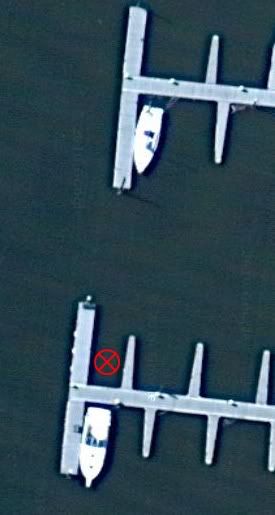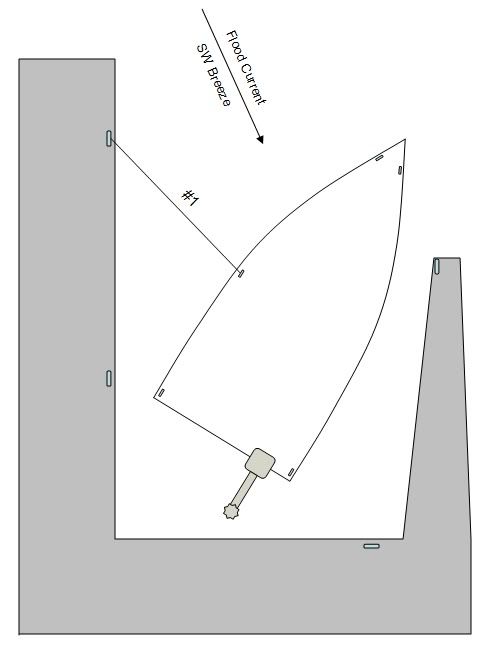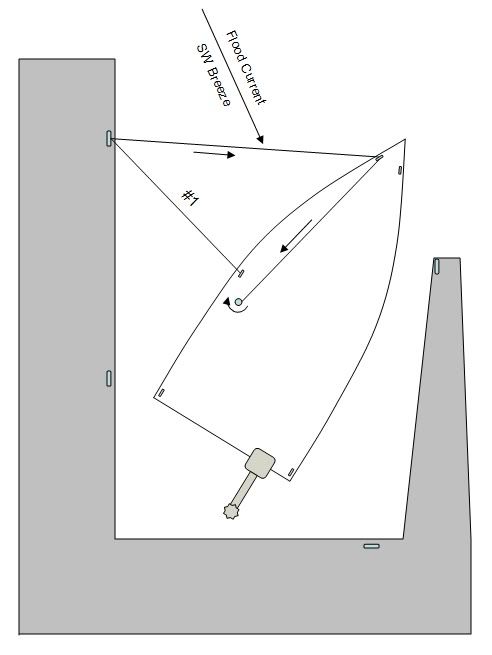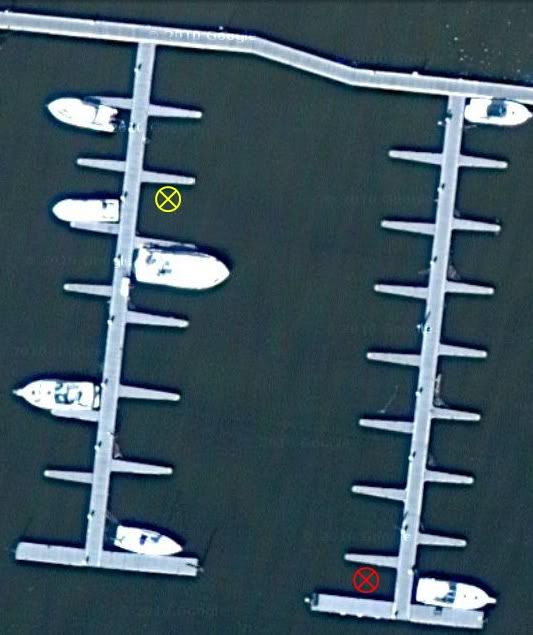Because I was nice to the marina manager last year, she gave me the only single slip in the whole marina in my size range (just inside a T-dock, marked below in red). There are no pilings in the water, so those who share double slips have to rely on fenders to keep from hitting the finger docks:
![Image]()
So after relying on fenders all last year, this year I have enough cleats and surrounding docks to keep the boat from rubbing the fenders, although I'll probably leave them out just in case:
![Image]()
Note that in the above pic I orient the boat diagonally to reduce stresses on the lines by aligning (somewhat) with the river current.
This gets to the point of my question. Docking on an ebb current is a piece of cake. Since the current is pushing the boat out of the slip and toward the T, I idle the motor in reverse and back in ever so slowly.
However, a flood current is a different story. When backing in with the current (therefore faster than I would like) I grab the spring line labeled "#1" with a boat hook and get it over the midship cleat as quickly as possible. That guarantees that our outboard or fragile rudder will not crash against the dock when backing in. I had hoped that continued backing against the spring line would pull the boat gently against the T-dock (as happened in my slip last year). But the currents are a little stronger in this dock, and they push the bow of the boat (and the underwater keel) hard to starboard, usually ending up like this:
![Image]()
Last night, with just the gentlest SW breeze, it took about 5 minutes of pulling as hard as I could and constantly readjusting my footing so I would not fall off the boat to get the bow pulled in enough to secure the line. In a stronger blow there is no way I would be able to do this. So I am thinking of attaching an additional line, about 30' long, to the cleat on the T-dock, leading it around the bow cleat (or perhaps around the base of the bow pulpit), and back to the winch so I could crank the bow toward the T-dock:
![Image]()
We would remove this line from the winch once we are docked and put a loop over the bow cleat to secure the boat.
Have any of you had to do something like this to get your boat into a slip? Any suggestions of something better?

So after relying on fenders all last year, this year I have enough cleats and surrounding docks to keep the boat from rubbing the fenders, although I'll probably leave them out just in case:

This gets to the point of my question. Docking on an ebb current is a piece of cake. Since the current is pushing the boat out of the slip and toward the T, I idle the motor in reverse and back in ever so slowly.
However, a flood current is a different story. When backing in with the current (therefore faster than I would like) I grab the spring line labeled "#1" with a boat hook and get it over the midship cleat as quickly as possible. That guarantees that our outboard or fragile rudder will not crash against the dock when backing in. I had hoped that continued backing against the spring line would pull the boat gently against the T-dock (as happened in my slip last year). But the currents are a little stronger in this dock, and they push the bow of the boat (and the underwater keel) hard to starboard, usually ending up like this:

Last night, with just the gentlest SW breeze, it took about 5 minutes of pulling as hard as I could and constantly readjusting my footing so I would not fall off the boat to get the bow pulled in enough to secure the line. In a stronger blow there is no way I would be able to do this. So I am thinking of attaching an additional line, about 30' long, to the cleat on the T-dock, leading it around the bow cleat (or perhaps around the base of the bow pulpit), and back to the winch so I could crank the bow toward the T-dock:

We would remove this line from the winch once we are docked and put a loop over the bow cleat to secure the boat.
Have any of you had to do something like this to get your boat into a slip? Any suggestions of something better?






